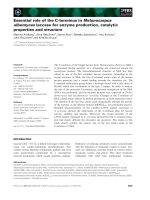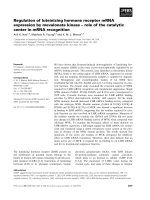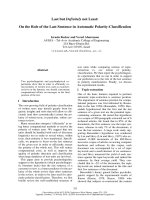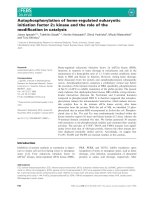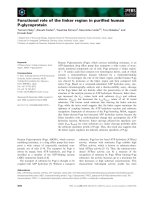Role of the shape deformation in 12C + 12C fusion at sub-Coulomb energies
Bạn đang xem bản rút gọn của tài liệu. Xem và tải ngay bản đầy đủ của tài liệu tại đây (725.59 KB, 7 trang )
SCIENCE AND TECHNOLOGY DEVELOPMENT JOURNAL:
NATURAL SCIENCES, VOL 2, ISSUE 4, 2018
112
Role of the shape deformation in 12C + 12C
fusion at sub-Coulomb energies
Le Hoang Chien, Bui Viet Anh, Thach Nguyen Ha Vy
Abstract—The fusion cross section of 12C+12C
system at the energies of astrophysical interest is
calculated in the framework of barrier penetration
model taking into account the deformed shape of
interacting nuclei. In particular, the quadrupole
surface deformation of both projectile and target
nuclei has been included during the fusion process.
The real and imaginary parts of nucleus-nucleus
interactions performed using the Woods-Saxon
square and Woods-Saxon functions, respectively
have been carefully tested by 12C-12C elastic
scattering data analysis before employed to evaluate
the astrophysical S factors (the fusion cross
sections). The optical model results of elastic angular
distributions are consistent with the experimental
data. Within the barrier penetration model, the real
part of the obtained optical potential gives a good
description of the non-resonant astrophysical S
factor. It turns out that the taking into account of
quadrupole deformation of 12C nuclei increases the
astrophysical S factor at energies below Coulomb
barrier.
Index Terms—Barrier penetration model,
deformation shape, fusion.
Received:
05-01-2018;
Published:15-10-2018.
Accepted
15-03-2018;
Le Hoang Chien, Bui Viet Anh, Thach Nguyen Ha Vy,
Faculty of Physics and Engineering Physics, University of
Science, VNUHCM.
(e-mail: ).
1 INTRODUCTION
tudy of 12C+12C fusion at low energies is
important to understand the carbon burning
stage in the massive stars (at least eight times of
solar mass). In fact, after the helium burning
phase, carbon nuclei are produced by the triple
alpha processes. Due to gravitational collapse, the
stars themselves increase their temperature to 10 8
K at which two 12C nuclei gain enough energy to
fuse into each other and generate heavy elements
such as 20Ne, 23Na, 23Mg. However, such typical
condition in the stars corresponding to the thermal
energy less than 1.5 MeV is not achieved in the
experiments at the present time because the fusion
cross section is estimated to be very small, in the
order of 10-10 mb. Moreover, in the energy region
around and well below the Coulomb barrier, the
prominent of resonant structures in 12C+12C fusion
excitation functions makes it extremely difficult
to extrapolate the fusion cross section at energies
of astrophysical interest from the available data at
the higher energies [1]. Therefore, during the last
four decades, 12C+12C fusion at low energies still
attracts a lot of experimental and theoretical
efforts [2-12].
S
In general, 12C+12C fusion cross sections at low
energies are calculated using the barrier
penetration model (BPM) [9, 10] that the reality
strongly depends on the choice of nuclear
potential. Indeed, a large number of potential
models have been proposed to study 12C+12C
fusion based on both the microscopic and
phenomenological approaches [9, 10, 12]. One
could note that it is significant to determine how
the potential model is good in the description of
12
C-12C nuclear interaction before employed to
calculate the fusion cross section. However, the
important step is rarely considered in previous
TẠP CHÍ PHÁT TRIỂN KHOA HỌC & CÔNG NGHỆ:
CHUYÊN SAN KHOA HỌC TỰ NHIÊN, TẬP 2, SỐ 4, 2018
113
studies [9, 10]. It is well known that the shape
deformation of nuclei is important to the fusion at
very low energies because the nucleus-nucleus
interaction is sensitive to the orientation of
incoming nuclei. As a result, the barrier heights
performed from the nuclear and Coulomb
potentials are expected to vary at various
orientations of interacting nuclei. The various
barrier height results in the changing of
transmission coefficient that affects the fusion
cross section. According to the experimental
measurements, the ground state shape of 12C
nuclei is well deformed [13]. Therefore, it is
important to take into account the deformed shape
of incoming nuclei in study of 12C+12C fusion at
low energies that previous studies have assumed
the ground state shape of 12C nuclei to be
spherical [9,12].
In this study, we focus on two important
problems relevant to the 12C+12C fusion at
energies below the Coulomb barrier. Firstly, 12C–
12
C nuclear potential at low energies performed
using the Woods-Saxon square form has been
carefully tested by the elastic scattering data
analysis over a wide range of energies before
applied into the BPM calculation. Secondly, the
astrophysical S factors of 12C+12C system are
calculated in the framework of BPM taking into
account the quadrupole surface deformation of 12C
incoming nuclei.
In the next section, the outline of theoretical
framework is described. Some calculated results
of the nuclear potentials, elastic angular
distributions and astrophysical S factors (fusion
cross sections) of 12C+12C system are given in the
section of results and discussions. We summarize
and conclude in the last section.
and transmit the beam in a way analogous to the
behavior of light. To describe this assumption, the
potential entered into the Schrodinger equation
having a complex form (named optical potential)
with the real and imaginary parts account for the
elastic and non-elastic scattering processes,
respectively. For detail derivation of OM
formalism, one can see in [14]. In general, the
differential cross section for the elastic scattering
of an identical system is given in the form
2 METHODS
The first and second terms of (4) correspond to
the real and imaginary components of nuclear
potential. The Coulomb potential VC and
Coulomb phase shift
are taken the explicit
formulas in [14].
Optical Model
A large number of calculations successfully
interprete the elastic scattering of nucleons and
nuclei by nuclei have involved in term of the
optical model (OM) analysis [14]. In the physical
point of view, the OM describes the nuclei as
cloudy balls which are heated by a beam of
incoming particles, they partially absorb, scatter,
f C () f C ( )
d
i
.
de
(2 1) exp(2i )(1 S ) P (cos())
k even
2
(1)
k 2μE /
2
(fm-1).
The
Coulomb
f
(
)
scattering amplitude C
is expressed in terms
and the
of the Coulomb phase shift
with
Sommerfeld parameter
f C ()
0.1574Z2 / E
2
exp iLn[sin ( / 2)] 2i 0
.
2k
sin 2 ( / 2)
S exp 2iδ
is
the
(2)
nuclear
scattering
amplitude with the nuclear phase shift
determined by solving the Schrodinger equation
2 d2
( 1)
U(r) VC (r)
2
2r 2
2 dr
2
E (r) 0.
(3)
12
12
is the reduced mass of C+ C system (MeV).
E is the center of mass energy (MeV) and
presents for the angular momentum between two
colliding nuclei. U(r) is the optical potential
(MeV) given in the form
U(r) VN (r) iWI (r).
(4)
Barrier Penetration Model
In the framework of BPM [9,10], the fusion
cross section induced by the collision of two
SCIENCE AND TECHNOLOGY DEVELOPMENT JOURNAL:
NATURAL SCIENCES, VOL 2, ISSUE 4, 2018
114
deformed nuclei could be averaged over all
possible orientations of incoming nuclei as
follows
F
2
k2
(2 1)
even
1
4
0
0
T (E, 1 , 2 )sin 1d1 sin 2 d2 .
(5)
Then, we use the useful treatment from the
WKB approximation to evaluate the transmission
coefficient given by
deformation parameters of colliding nuclei,
respectively. f12, f2, f3 are functions originated
from multipole expansion of the Coulomb
potential with respect to the orientation angles.
The nuclear angle-dependent interaction can be
assumed as [15]
VN (r) VN0 (r) (R10β12 Y10 R 20β 22 Y20 )
The superscript 0 in (9) presents for the
spherical case of nuclear potential.
1
r2 (E, ,1 ,2 )
T (E, 1 , 2 ) 1 exp
t(r, E, , 1 , 2 ) dr ,
r1 (E, ,1 ,2 )
t(r, E, , 1 , 2 )
8
2
V(r, E, , 1 , 2 ) E .
(6)
Here r1, r2 are the classical turning points where
V(r1 , E, , 1 , 2 ) V(r2 , E, , 1 , 2 ) E .
The effective potential V composing of the
Coulomb, real part of nuclear and centrifugal
( , )
interactions that depends on the angles 1 2 .
1 , 2 are the orientation angles of the projectile
and target nuclei, respectively. The Coulomb
interaction of two deformed nuclei is
approximately calculated as follows [10]
VC (r,θ1 ,θ 2 )
Z1 Z2 e2
r
2
f12β12 f12β 22 f 2β12
,
2
f 2β 22 f3β12β 22 1
(7)
where,
f12 (r,θi , R i0 )
f 2 (r,θi , R i0 )
3R i02
Y20 (θi )
(2 1) r 2
6 5R i02
3 π r2
f 3 (r,θ1 ,θ 2 , R10 , R 20 )
Y20 (θi ) with i 1, 2.
2
R10
R 220
r4
3
20π
51
3
Y20 (θ1 )Y20 (θ 2 )
Y20 (θ1 ) Y20 (θ 2 ) .
25
10 5π
(8)
R10, R20 correspond to the spherical radius of
projectile and target nuclei. β12, β22 are quadrupole
dVN0 (r)
.
dr
(9)
3 RESULTS AND DISCUSSIONS
12
C+12C Nuclear Potential
First, we search for the 12C-12C realistic nuclear
potential at low energies using the framework of
OM calculations with the complex potential as
described in (1)-(4). Seven elastic scattering
angular distributions in laboratory energies
between 1 and 6 MeV/nucleon, slightly above the
Coulomb barrier [16], have been used in the
searching the nuclear potential. The complex
nuclear potential, as seen in (4), is assumed to
have the phenomenological forms. The literature
review of previous studies shows that the shallow
potential has been often used to analysis the
scattering data of 12C+12C system at energies
below 6 MeV/nucleon [17]. However, the family
of deep potential has been considered as an
appropriate choice to describe the experimental
data in the higher energies [18, 19]. Based on the
light of study in [18], the 12C-12C potential at low
energies could prefer to the deep type that is
strong enough to keep two 12C nuclei in the
cluster state of the compound 24Mg nucleus.
Therefore, in this work, the real part of the
complex nuclear potential at low energies is
assumed to have a Woods-Saxon (WS) square
shape that is the deep type and very similar to the
shape of the microscopic folding potential [20].
The standard WS form is taken to describe the
imaginary part. There are six adjustable
parameters of V0, R, a, W0, RI, aI, as seen in (10),
accounting for the central depth, reduced radius,
and diffuseness of the real and imaginary nuclear
potentials, respectively. These parameters are
chosen to give the best description of elastic
angular distribution data. In particular, each
TẠP CHÍ PHÁT TRIỂN KHOA HỌC & CÔNG NGHỆ:
CHUYÊN SAN KHOA HỌC TỰ NHIÊN, TẬP 2, SỐ 4, 2018
115
elastic angular distribution is analyzed
independently by varying these parameters to fit
the experimental data. It means that at the minima
six parameters correspond to the optimum
potential with the shape and strength similar to the
actual 12C-12C nuclear interactions.
U(r)
V0 (E)
rR
1 exp( a )
2
iW0 (E)
.
r RI
1 exp(
)
aI
(10)
The comparison of elastic angular distributions
obtained from the OM calculations with the
experimental data in the energy range between
1 and 6 MeV/nucleon is shown in fig. 1 and fig. 2.
One can see that the main structure of all angular
distributions from the backward to forward angles
is well reproduced with OM results using the
potential parameters as listed in table I. The
difference of differential cross sections at the
minima and maxima between the calculated and
measured results are reasonably accepted. One
notes that the pattern of angular distributions at
the backward angles is formed by the interference
between the direct and reflected waves scattering
in the interior region of potential while that at the
forwards angles is originated from the
interference of the waves incoming at the surface
potential. It indicates that the nuclear potentials
with parameters in table I have the reasonable
depth and strength from the interior to surface that
can be used to describe the actual 12C-12C
interaction at low energies.
Table 1. Parameters of the optical potential (10).
The volume integrals for the real (JV) and imaginary (JW) parts
of nuclear potentials get the unit of MeVfm3
Elab
V0
r
a
W0
rI
aI
(MeV) (MeV)
(fm)
(fm)
(MeV)
(fm)
(fm)
16
372.0
0.751 1.421 2.241
1.468 0.218
JV = 363
JW = 18
18
370.0
0.751 1.421 2.442
1.418 0.260
JV = 360
JW = 17
20
367.0
0.751 1.421 2.866
1.431 0.215
JV = 357
JW = 21
35
363.0
0.753 1.426 2.399
1.574 0.202
JV = 357
JW = 24
40
260.0
0.752 1.426 3.069
1.486 0.201
JV = 352
JW = 26
45
365.0
0.755 1.428 3.427
1.426 0.232
JV = 361
JW = 25
50
357.0
0.755 1.428 4.479
1.403 0.333
JV = 353
JW = 30
Fig. 1. The elastic angular distributions for 12C + 12C system at
the laboratory energies of 16, 18, 20 MeV. The solid lines and
dotted lines account for the OM calculations using the
potential model in this work and Brandan potential,
respectively. The data are taken from [3].
Fig. 2. The same as fig. 1 but for the laboratory energies of
30, 40, 45, 50 MeV [17]
For investigating whether the nuclear complex
potentials performed in this work are unique or
not, we calculate the volume integrals for the real
(JV) and imaginary (JW) parts of nuclear potentials
using the formula in [19] whose values are listed
in table I. We make a comparison of the volume
SCIENCE AND TECHNOLOGY DEVELOPMENT JOURNAL:
NATURAL SCIENCES, VOL 2, ISSUE 4, 2018
116
integrals between the potential model in this work
typical for low energies and the previous model
giving a good description of the scattering data at
higher energies. It is shown that there is a
consistent continuation of the JV and JW values
from the low energies to the higher energy region
[19]. In the energy region below 6 MeV/nucleon,
there are also some shallow and deep potential
families [19] with the volume integrals JV that is
discrete with those of the potential family from
higher energies. The discontinuity of volume
integrals is ambiguous and unreasonable. Thus,
we take a deep type potential of WS form
(V0=386.2-0.868Elab (MeV), r=0.583 (fm),
a=0.902 (fm), W0=0.091Elab (MeV), rI=1.449
(fm), aI=0.318 (fm)), one of mentioned discrete
potentials named BrandanPot, as an example to
analyze the 12C+12C elastic scattering data, as seen
in Fig. 1 and Fig. 2. The BrandanPot potential
fails to describe the elastic angular distributions.
Therefore, based on the elastic scattering analysis
and the consistent continuation of volume
integrals from high to low energies, it is
reasonable to use the nuclear potential family
obtained in this work to study the 12C+12C fusion
at low energies.
12
C+12C fusion
In general, the astrophysical S factor that is the
typical input for the fusion at energies of
astrophysical interest is defined as a function of
system energy and fusion cross section
S E σ exp(2πη).
(11)
where σ is calculated in the framework of
BPM.
It is well known that the shape deformation of
colliding nuclei is important to the sub-barrier
fusion due to the dependence of the barrier high
on the orientation of incoming nuclei [10]. The
ground state shape of 12C nuclei is well deformed
with the quadrupole and hexadecapole
deformations obviously observed. In this work,
we consider the effect of quadrupole deformation
(correspond to β2 = -0.40 ± 0.02 (fm)) [13] on
12
C+12C fusion at sub-Coulomb energies. To
investigate the role of shape deformation in
12
C+12C fusion, we have constructed the deformed
Coulomb and nuclear potential corresponding to
the case of two axial-symmetric nuclei, as
described in (7) and (9).
Fig. 3. Astrophysical S factor from 12C+12C system at subCoulomb energies. Data are taken from Ref. [4-7].
The comparison between the calculated results
of S factors from 12C+12C fusion at energies below
Coulomb barrier and the measured data [4-7] is
illustrated in fig. 3. The solid line presents for the
S factor calculated in the framework of BPM
using the spherical potentials. The dotted line and
dashed line describe the results in two
approximations of one and two deformed nuclei,
respectively. The data measured by various
experimental groups are significantly different at
energies below 5 MeV with strongly resonant
peaks. However, the calculated results are
consistent with most of the non-resonant data.
One can see that the deformed effects on the
astrophysical S factor are clearly obvious in the
energy region below 5 MeV where is involved in
the study of the fusion in star conditions while it
can be negligible at the higher energies. The
collision of quadruple deformed target and
spherical projectile produces higher astrophysical
S factor in the order of 1.5 times than the
spherical case. The simultaneous including of the
quadrupole deformations in both target and
projectile leads to the larger values of the
astrophysical S factor. It is clear to indicate that
TẠP CHÍ PHÁT TRIỂN KHOA HỌC & CÔNG NGHỆ:
CHUYÊN SAN KHOA HỌC TỰ NHIÊN, TẬP 2, SỐ 4, 2018
the role of deformed shape of colliding nuclei is
not negligible in 12C+12C fusion study.
4 CONCLUSION
The OM and volume integral analyses show
that the nuclear potential of 12C+12C system at low
energies prefer to the deep family consistently
connecting to the potential family in higher
energy region. The astrophysical S factors from
12
C+12C system calculated in the framework of
BPM using the scattering potential with taking
into account the quadrupole deformation of
nuclear 12C surface agree well with the nonresonant data. Our calculations figure out that the
account of the quadrupole deformation of 12C
nuclei induces the increasing of the astrophysical
S factor at sub-barrier energies. The including of
surface deformation of 12C nuclei during the
collision is important for the accurate calculation
of the astrophysical S factor at the Gamow
energies. The 12C nuclei has well deformed
surface clearly dominated by not only the
quadrupole
but
also
the
hexadecapole
deformations. Therefore, the further calculation of
12
C+12C fusion at low energies should be done by
taking into account both surface deformations of
colliding nuclei.
TÀI LIỆU THAM KHẢO
[1]. M.E. Bennett, R. Hirschi, M. Pignatari, S. Diehl, C.
Fryer, F. Herwig, A. Hungerford, K. Nomoto, G.
Rockefeller, F.X. Timmes, M. Wiescher, The effect of
12
C +12C rate uncertainties on the evolution and
nucleosynthesis of massive stars, MNRAS, 420, 3047–
3070, 2012, DOI: 10.1111/j.1365-2966.2012.20193.x.
[2]. D.A. Bromley, J.A. Kuehner, E. Almquist, Resonant
elastic scattering of 12C by carbon, Phys. Rev. Lett.,
vol.
4,
pp.
365–367,
1960,
DOI:
10.1103/PhysRevLett.4.365.
[3]. W. Treu, H. Frohlich, W. Galster, P. Duck, H. Voit, Total
reaction cross section for 12C + 12C in the vicinity of the
Coulomb barrier, Phys. Rev. C, 22, 2462–2464, Dec.
1980, DOI: 10.1103/PhysRevC.22.2462.
[4]. J.R. Patterson, H. Winkler, C.S. Zaidins, Experimental
investigation of the stellar nuclear reaction 12C + 12C at
low energies, ApJ., 157, 367–373, 1969, DOI:
10.1086/150073.
[5]. M.G. Mazarakis and W.E. Stephens, Experimental
measurements of the 12C+ 12C nuclear reactions at low
energies”, Phys. Rev. C, 7, 1280–1287, 1973, DOI:
10.1103/PhysRevC.7.1280.
117
[6]. E.F. Aguilera, P. Rosales, E. Martinez-Quiroz, G.
Murillo, M. Fernández, H. Berdejo, D. Lizcano, A.
Gómez-Camacho, R. Policroniades, A. Varela, E.
Moreno, E. Chávez, M. E. Ortíz, A. Huerta, T. Belyaeva,
and M. Wiescher, New γ-ray measurements for 12C+12C
sub-Coulomb fusion: Toward data unification, Phys. Rev.
C,
73,
064601–1–12,
2006,
DOI:
10.1103/PhysRevC.73.064601.
[7]. M. Notani, H. Esbensen, X. Fang, B. Bucher, P. Davies,
C.L. Jiang, L. Lamm, C.J. Lin, C. Ma, E. Martin, K.E.
Rehm, W.P. Tan, S. Thomas, X.D. Tang, E. Brown,
Correlation between the 12C+12C, 12C+13C, and 13C+13C
fusion cross sections, Phys. Rev. C,. 85, 014607–1–7, Jan.
2012, DOI: 10.1103/PhysRevC.85.014607.
[8]. B. Bucher et al., “First Direct Measurement of
12
C(12C,n)23Mg at Stellar Energies”, Phys. Rev. Lett., 114,
251102–1–6,
2015,
DOI:
10.1103/PhysRevLett.114.251102.
[9]. L.R. Gasques, A.V. Afanasjev, E.F. Aguilera, M. Beard,
L.C. Chamon, P. Ring, M. Wiescher, and D.G. Yakovlev,
Nuclear fusion in dense matter: Reaction rate and carbon
burning, Phys. Rev. C, 72, 025806–1–14, 2005, DOI:
10.1103/PhysRevC.72.025806.
[10]. V.Yu. Denisov, N. A. Pilipenko, Fusion of deformed
nuclei: 12C+12C, Phys. Rev. C, 81, 025805–1–5, 2010,
DOI: 10.1103/PhysRevC.81.025805.
[11]. C.L. Jiang, B.B. Back, H. Esbensen, R.V.F. Janssens,
K.E. Rehm, R.J. Charity, Origin and consequences of 12C
+ 12C fusion resonances at deep sub-barrier energies,
Phys. Rev. Lett.,. 110, 072701–1–5, Feb. 2013, DOI:
10.1103/PhysRevLett.110.072701.
[12]. M. Assunção, P. Descouvemont, Role of the Hoyle state
in the 12C+12C fusion, Phys. Lett. B, 723, 355–359, May
2013, DOI: 10.1016/j.physletb.2013.05.030.
[13]. M. Yasue, T. Tanabe, F. Soga, J. Kokame, F. Shimokoshi,
J. Kasagi, Y. Toba, Y. Kadota, T. Ohsawa, K. Furuno,
Deformation parameter of 12C via 12C(α,α’) and 12C(α,
α’α),
Nucl. Phys. A, 394, 29–38, 1983, DOI:
10.1016/0375-9474(83)90159-8.
[14]. G.R. Satchler, Direct nuclear reactions, in Clarendon
Press, Oxford, United Kingdom, 28, 1983.
[15]. L.C. Chamon, G.P.A. Nobre, D. Pereira, E.S. Rossi, Jr.,
and C. P. Silva, Coulomb and nuclear potentials between
deformed nuclei, Phys. Rev. C, 70, 014604–1–8, 2004,
DOI: 10.1103/PhysRevC.70.014604.
[16]. R.G. Stokstad, R.M. Wieland, G.R. Satchler, C.B. Fulmer,
D.C. Hensley, S. Raman, L.D. Rickertsen, A.H. Snell,
P.H. Stelson, Elastic and inelastic scattering of 12C by 12C
from Ec.m. = 35−63 MeV, Phys. Rev. C, 20, 655–669,
1979, DOI: 10.1103/PhysRevC.20.655.
[17]. W. Reilly, R. Weiland, A. Gobbi, M. W. Sachs, J. Maher,
R. H. Siemssen, D. Mingay, D.A. Bromley, Elasticscattering excitation functions for the 12C-12C system,
Nuovo
Cimento,
13,
913–922,
1973,
DOI:
10.1007/BF02804158.
[18]. Y. Kondo, M.E. Brandan, and G.R. Satchler, Shape
resonances and deep optical potentials: A mean-field
description of 12C+12C scattering at low energies, Nucl.
118
SCIENCE AND TECHNOLOGY DEVELOPMENT JOURNAL:
NATURAL SCIENCES, VOL 2, ISSUE 4, 2018
Phys. A, 637, 175-200, 1998, DOI: 10.1016/S03759474(98)00212-7.
[19]. M.E. Brandan, M. Rodríguez-Villafuerte, A. Ayala, 12C+
12
C elastic scattering analysis above E/A=6 MeV using
deep potentials, Phys. Rev. C, vol. 41,. 1520–1529, 1990,
DOI: 10.1103/PhysRevC.41.1520.
[20]. Dao T. Khoa, G. R. Satchler, Generalized folding model
for elastic and inelastic nucleus–nucleus scattering using
realistic density dependent nucleon–nucleon interaction,
Nucl. Phys. A,. 668, 3–41, 2000, DOI: 10.1016/S03759474(99)00680-6.
Ảnh hưởng của biến dạng bề mặt hạt nhân
lên phản ứng tổng hợp 12C+12C ở vùng
năng lượng thấp
Lê Hoàng Chiến*, Bùi Việt Anh, Thạch Nguyễn Hà Vy
Trường Đại học Khoa học Tự nhiên, ĐHQG-HCM
*Tác giả liên hệ:
Ngày nhận bản thảo: 05-01-2018, Ngày chấp nhận đăng: 15-3-2018, Ngày đăng: 15-10-2018.
Tóm tắt—Phản ứng tổng hợp 12C+12C ở vùng
năng lượng thiên văn được tính toán dựa trên mẫu
xuyên rào lượng tử trong đó có kể đến ảnh hưởng
của biến dạng bề mặt hạt nhân. Cụ thể, ảnh hưởng
của biến dạng tứ cực lên tiết diện tổng hợp được
khảo sát. Phần thực và ảo của thế tương tác hạt
nhân được xây dựng lần lượt dựa trên dạng hàm
Woods-Saxon bình phương và Woods-Saxon, đồng
thời chúng được kiểm tra qua phân tích số liệu tán
xạ 12C-12C ở vùng năng lượng gần ngưỡng Coulomb
trước khi sử dụng trong các tính toán mẫu xuyên
rào lượng tử. Kết quả tính toán của phân bố góc là
phù hợp với dữ liệu thực nghiệm. Đồng thời, giá trị
của hệ số thiên văn S trùng khớp với số liệu đo đạt
trong trường hợp không cộng hưởng. Kết quả phân
tích cho thấy việc kể đến biến dạng tứ cực của bề
mặt hạt nhân 12C làm tăng tiết diện phản ứng tổng
hợp ở vùng năng lượng dưới ngưỡng Coulomb.
Từ khóa—mô hình quang học, mẫu xuyên rào, phản ứng tổng hợp.


